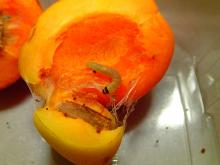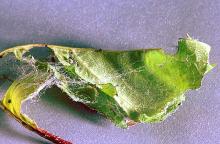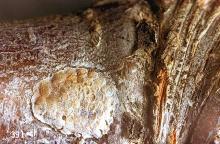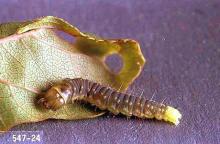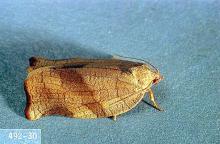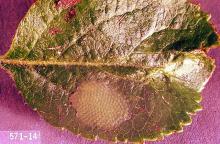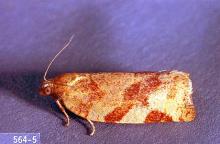Includes
Fruittree leafroller (Archips argyrospila)
Obliquebanded leafroller (Choristoneura rosaceana)
Pandemis leafroller (Pandemis pyrusana)
Pest description and crop damage There are several species of leafroller pests in tree fruits. These leafrollers use native plants as well as fruit trees as hosts. They all cause similar damage to the trees, but they differ in their appearance and, more importantly, in their life cycle. The principal leafroller pests of fruit trees can be divided into single-generation moths, such as the fruittree leafroller, and two-generation moths, such as the obliquebanded leafroller and the pandemis leafroller.
The adult moths of these leafrollers range from fawn color to dark brown. There are distinctive bands or mottling on the wings. Wingspans range from 0.5 to 1 inch. The larvae of these species are all green caterpillars with a light brown to black head, depending on the species. Mature larvae range from 0.75 to 1 inch long.
As the name "leafroller" implies, the larvae roll and tie leaves together for shelter and feeding. They thrash about violently when disturbed and may drop from the leaf suspended by a silken thread. Feeding on growing points on young plants can promote undesirable branching. Larvae also feed on the surface of the fruit, causing deep, russeted scars.
Biology and life history The single-generation leafrollers overwinter as egg masses on twigs and branches. Eggs hatch in spring as buds are opening until petal fall. The larvae feed for 4 to 6 weeks, then pupate in the rolled leaves and emerge as moths in early summer. The overwintering eggs are laid in July.
Two-generation leafrollers overwinter as immature larvae under the bark on scaffold branches of a variety of host plants. Larvae may feed during warm periods in winter but become active in spring with the onset of new growth. They feed for several weeks and then pupate in rolled leaves. Adults emerge in late April to May. These moths lay eggs for the next generation. The next generation hatches in early summer and does the most damage.
Pest monitoring Observe early spring growth for feeding damage on new leaves or flower petals; later in the spring scout for rolled leaves. Species-specific pheromone traps can monitor moth activity, but moth abundance is not a good indicator of leafroller density and potential damage.
Management-cultural and biological control
Spiders, general predators, and parasitic wasps may reduce these populations. When possible, conserve these predator and parasite populations by avoiding broad-spectrum insecticides. In home orchards, hand-picking rolled leaves with larvae and pupae reduces leafroller populations.
Management-chemical control
Dormant or delayed-dormant applications target the overwintering life stages of leafrollers. Apply sprays with enough water to cover entire tree thoroughly including small limbs. Apply only during dormant or delayed dormant period. These sprays are most effective on leafrollers with one generation per year that overwinter primarily in the egg stage. Applications during the growing season must be well timed so spray residues contact the newly hatched larvae before they can web leaves together and escape subsequent spray applications.
Management-chemical control: HOME USE
Dormant-season spray
- horticultural mineral oil-Some formulations OMRI-listed for organic use.
Growing-season spray
Warning: Many pesticides are hazardous to bees. Look for bee precautionary statements on product labels and do not use these products during bloom or if bees are foraging in the orchard.
- azadirachtin-Some formulations are OMRI-listed for organic use.
- carbaryl-Highly toxic to bees.
- gamma-cyhalothrin-Highly toxic to bees.
- horticultural mineral oil-Some formulations OMRI-listed for organic use.
- kaolin-When sprayed on leaves, trunks, and fruit, kaolin acts as a repellant to some insects. Some formulations are OMRI-listed for organic use.
- lambda-cyhalothrin-Highly toxic to bees.
- malathion-Highly toxic to bees.
- plant-derived essential oils-Some have shown efficacy against leafrollers. Some formulations are OMRI-listed for organic use.
- pyrethrins-Highly toxic to bees. Some formulations are OMRI-listed for organic use.
- spinosad-Some formulations are OMRI-listed for organic use.
- zeta-cypermethrin-Highly toxic to bees.
Management-chemical control: COMMERCIAL USE
For orchards with a history of leafroller problems, direct cover sprays in the early spring at the overwintering generations for best control. Summer generations of leafrollers are more difficult to control.
Petal fall, spring, and summer sprays
- Bacillus thuringiensis var. kurstaki-Formulations vary; check label for rates. REI 4 hr. PHI 0 days. Nontoxic to bees. This biologically derived material is slow acting and requires good coverage and multiple applications to be effective. Apply when forecast calls for warm daily temperatures. This material is less effective during cool weather when larvae are not actively eating. Some formulations are OMRI-listed for organic use.
- chlorantraniliprole (Altacor 35WDG) at 3 to 4.5 oz/A (0.066 to 0.099 lb ai/A). REI 4 hr. PHI 10 days.
- methoxyfenozide (Intrepid 2F) at 8 to 16 fl oz/A. REI 4 hr. PHI 7 days.
- spinetoram (Delegate 25WG) at 4.5 to 7 oz/A. REI 4 hr. PHI 14 days.
- spinosad (Entrust 80W) at 0.4 to 0.8 oz/100 gal water (1.25 to 2.5 oz/A). REI 4 hr. PHI 14 days. Results are best when applied at petal fall. OMRI-listed for organic use. May act slowly.
Resistance management Leafrollers can develop resistance rapidly to chemical controls. Do not treat consecutive generations with pesticides representing the same chemical group or mode of action. Spinetoram and spinosad are group 5 products.


